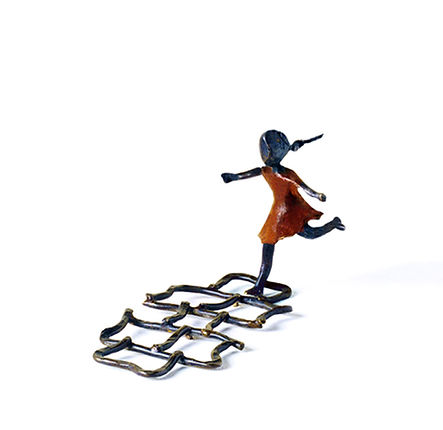
EXHIBITION
ONLINE
Hopscotch
Bronze
21 x 12 x 30 cm
2006
Childhood Scenes
“The hopscotch squares were drawn with a toe on red earth that knew no asphalt. In its wealth of wobbly lines, the girl wrote: Heaven and Hell, and girlishly wondered: Is Heaven spelt with or without en?”
Number of players: 2 to 10
Age group: up to 10
Materials: an instrument for drawing on the ground (chalk, wax crayon, stick if played on sand) and a stone or the like for throwing
Space requirements: indoors or outdoors
Duration: approximately 20 minutes
Interesting facts:
Hopscotch was one of the games introduced by the Portuguese along with their tales, legends, stories and celebrations. Hopscotch has a long history and is found in nearly every corner of Brazil. It goes by many different names: in the state of Minas Gerais it is known as mar? (tide); in Rio Grande do Norte it is called avião (airplane); in Bahia, the players pular macaco (jump the stone); in Portugal, children play jogo da macaca (the stone game); in France, the game is called marelle, which gives origin to the Portuguese names, amarelinha and maré. Hopscotch has been linked to myths where labyrinths define the path for heaven bound spirits following death. It is said this was originally a way for children to relate playfully with the supernatural. The design of the hopscotch board may vary considerably and should take into consideration the size of the players.
Description:
Players form a line in the order they will jump. The first player throws the stone onto square 1, then hops to square 2 and so on until square 10. He turns and hops back, picking up the stone without stepping on square 1, then jumps onto the latter and continues the sequence by throwing the stone onto square 2. Only one foot may touch each square: the child must balance on one foot on the single squares, and use one foot on each of the double squares. The winner is the player able to hit square 10 with the stone. A player loses his turn if he throws the stone outside the corresponding square, steps on one of the lines, loses his balance, or steps on the square where the stone is. When it's his turn again, he begins with the number on which he made the mistake. The game ends when the sequence of jumps is completed, establishing second place, third place, etc.
Variation 1: With "heaven" and "hell"
When the drawing includes "hell", the stone is thrown from beside it, and whoever steps into it loses his turn. When the drawing includes "heaven" players may jump into it any way they choose when they reach square 10.
Variation 2: Balancing the stone
After the basic sequence has been completed, players may continue, holding the stone with their arm or leg, on their head, foot, shoulder or back of the hand, or discarding the stone and blindfolding the eyes. When using a leg to hold the stone, players hop on only one leg as they secure the stone behind their bent knee. In the other variations, players walk rather than hop. When the foot is use, players push the stone with the right foot and are allowed to touch the lines.
© 2017 by Sandra Guinle. Design and photography Ines Lampreia

All rights reserved. None of the works displayed may be reproduced or transmitted in any form or by any means, electronic or mechanical, including photocopying, recording or database, without the author's permission. Offenders will be prosecuted under the law.



